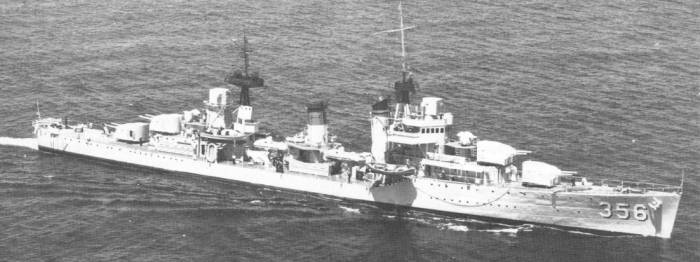

Design History
Still, initial design efforts in early 1932 still considered leader characteristics to be important enough. In its initial studies, the General Board was prepared to use the 350 tons increase (from the 1,500 tons standard of the Farragut class) for little more than light protection of vulnerable spaces and improved communications facilities. Considering this very little to show for 350 tons, the General Board picked a different scheme, with six single centerline guns, but no leader capacity.
In May 1932, the General Board despatched a set of recommendations for a design of such a vessel to the Secretary of the Navy. Not long into the design process, C&R advocated a change of armament to four twin mounts, single-purpose instead of dual-purpose, and reliance on small automatic weapons for air defense, as a practical alternative. Given the mission of the new ship, the change was accepted, leading to new specifications for eight 5" L/38 SP guns, eight torpedo tubes, two quadruple 28mm L/70 guns, and two .50-caliber machine-guns.
The completed design followed these lines, provided for eight reload torpedoes, and carried engines for 50,000shp output, increasing the speed of the new ships to 37 knots despite their larger displacement compared with the Farragut class. Two emergency diesel generators would provide power if the engines or boilers were disabled. Two fire-control directors were available, one above the bridge and one on the heavy superstructure aft.
Four Porters were initially funded for FY34, but the under the National Industrial Recovery Act of President Roosevelt's first administration, four were were funded in an effort to reduce unemployment. New York Shipbuilding did the final design. Bethlehem Steel (Quincy, MA) and New York Shipbuilding each produced four ships.
In 1943, the 20mm and 28mm mounts aft were replaced by two twin 40mm mounts.
Early in 1944, no.3 5" L/38 mount was removed in favor of a quadruple 40mm mount. Selfridge, Phelps and Winslow were modified in 1944/45 to carry a twin dual-purpose 5" L/38 mount in no. 1 and 4 positions, a single dual-purpose 5" L/38 in no.3 position, and a quadruple 40mm in no.2 position, making these ships far more effective under the conditions of the time. Winslow and Phelps lost one of their torpedo mounts in 1945 in favor of replacing the two twin 40mms aft with two quads. Both ships received elaborate 40mm directors. Clark, Moffett and Balch were not refitted in this manner, McDougal received a Selfridge-like refit in the Atlantic.
Service History
At the same time, roughly, that the Farragut class was designed, requirements for a destroyer leader were circulated among the Bureaus. The main problem which these ships were to deal with was the lack of available light cruisers to aid the other destroyers in their torpedo attacks; the main mission of the new leaders would be to use their gun armament to break through the enemy screen and allow the following destroyers to do likewise. In May 1928, an initial design was proposed, which developed through the following years and culminated in an August 1930 request by the Commander-in-Chief, U.S. Fleet, for development of such a leader. By late 1930, the unanimous opinion of the fleet was that a large destroyer was needed to take over some of the duties of the preferable, but hard-to-get, light cruisers.
 Modification History
Modification History
The European war soon indicated that heavier anti-air weaponry was needed by destroyers, but all plans for modifying the Porters to hold dual-purpose mounts turned out initially useless for a lack of such mounts. In 1941, the heavy after superstructure and main mast were removed, seriously altering the appearance of these ships. The removal of the heavy fire-control equipment allowed for the installation of two 20mm and another 28mm mount, and the addition of a Mk3 (FC) fire-control radar. Also removed were the containers for reserve torpedoes.
Three ships, McDougal, Winslow and Moffett served in the Atlantic during the war. The five Pacific ships served as leaders (ironically) pre-war, escorting carriers for the better part of 1942. Porter was lost in October 1942, escorting Hornet; she was torpedoed by a Japanese submarine. Selfridge suffered heavy damage in surface action in 1943, but the remainder of the vessels' careers was uneventful. All were scrapped shortly after the war safe Winslow, which served as a trials ship into the fifties.
Ships in class:
DD-356 Porter
DD-357 Selfridge
DD-358 McDougal
DD-359 Winslow
DD-360 Phelps
DD-361 Clark
DD-362 Moffett
DD-363 Balch
|
|
Displacements:
Standard: 2,154 tons Full: 2,857 tons Length: 116,13m / 381ft 0,5" Beam: 10,98m / 36ft 5/8" Draft (Full Load): 4,20m / 13ft 9,75" Crew (Officers/Men): 13/193 Endurance: 4,080nm at 15 knots Speed: 37 knots |
|
|
Belt: No belt armor
Deck: No deck armor Barbettes: No barbette armor Conning Tower: No conning tower armor |
|
|
(As designed):
Main: 8 x 127mm L/38, in twins: two forward, superfiring, two aft, superfiring Secondary: None AA: 8 x 28mm L/73 in two quad mounts, 2 x 12.7mm L/90 Torpedoes: 8 533mm torpedo tubes in two centerline quadruple mounts Depth Charges: 2 x depth charge track, 14 depth charges (Balch, August 1943):
(Selfridge, April 1945):
|